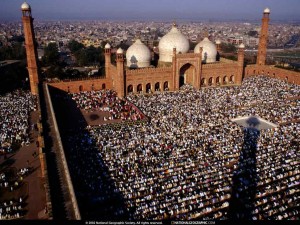Sights and Sounds of Pakistan: Lahore Part-1
Friday, May 11th, 2012 5:21:12 by Naveed A Bari
Sights and Sounds of Pakistan: Lahore Part-1
There is a Persian saying that if there was no Lahore, Isphahan (Iran) would have been half of the world. There is yet another ancient proverb, "Even if Persia’s Shiraz and Isphahan were united, they wouldn’t make one Lahore." So true till date and anyone
who visits Lahore for once, always misses the warmth of its people and the lively environ that prevails all over the city, be it the posh localities or the narrow gullies of old Lahore.
Lahore is the city of poets, artists and the centre of Pakistan film industry and city of gardens since some of the finest gardens in the continent are found here. It has the largest number of educational institutions in the country, which includes the century
old Punjab University and the Government College and University.
Lahore, or Laha-war, Laha-noor, Loh-pur, Mahmood-pur or Lohar-pur, has existed even in 1000 BC, when it was founded by Prince Loh, son of Rama Chandra. In 630 AD, the city was visited by Hieun Tsang, who remarked it as a Great Brahman City.
However Lahore rose to its glory in the times of the Mughal Empire and thereafter when many a landmark appeared on its landscape. In 1021 AD, Mahmood Ghaznavi Captured Lahore.
From 1186-1206, Shahab-ud-Din Ghauri conquered and reigned Lahore and brought it under the Ghorid Empire. In between 1241-1310, the Mongols ransacked Lahore many a time, while Tamerlane plundered Lahore in 1398.
In 1524 Zaheer-ud-Din Babur, the first Mughal emperor captured Lahore (painting on left) and hence founded the Mughal empire which lasted till 1857, when British took over the entire Indian Sub-Continent.
Lahore rose to its peak of glory in the reign of Mughal Emperor Akbar, who made it his capital and held his court In Lahore for 14 years from 1584 to 1598, and built the Lahore Fort, as well as the city walls which had 12 gates. Some of these still survive.
His son, Jahangir, is buried in its outskirts. Close by is the mausoleum of the famous Mogul Empress, Noor Jahan, who is known for introducing the rose plant and for initiating several cultural movements in the Sub-Continent.
The last great Mogul emperor, Aurangzeb (1838 – 1707) built Lahore’s most famous monument, the great Badshahi Mosque. At that time the river Ravi, which now lies a few miles away from Lahore, touched the ramparts of the Fort and the Mosque.
Lahore used to be a fortified city of twelve massive gates, whose names have outlived the largely pillaged walls. It has been a great city for at least a thousand years, but not when it was conquered, manhandled, occupied and ransacked by the Sikhs when
they took advantage of the Mogul decline in the eighteenth century to seize the Punjab in 1764.
To be continued…
Tags: Chilas, Kaghan, Mirnshah, Naran, Pakistan Children of the TalibanShort URL: https://www.newspakistan.pk/?p=22080

















